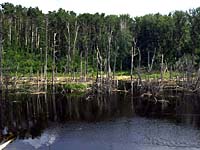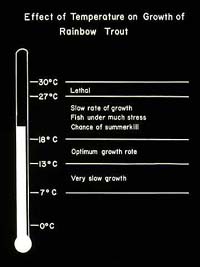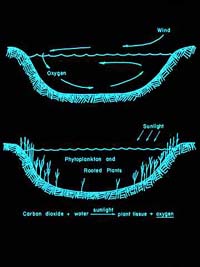
1. Optimum water temperatures for rainbow trout growth are from 13oC to 18oC. At temperatures above 21oC trout growth is reduced considerably. Trout can survive in water with temperatures up to 24oC for very short periods, and, with an abundant oxygen supply, up to 27oC. Rapid fluctuations in temperature usually cannot be tolerated and result in death to the fish. Higher temperatures for extended periods of time increase stress to the fish and the end result is poorer quality of meat. 2. Trout require a high level of oxygen. Oxygen concentration is dependent upon the temperature of the water; cool water holds more dissolved oxygen than warm water. Circulation of water also influences the amount of oxygen available to the fish. For example, wind action on a pond can increase oxygen levels. It is important that the water circulate on a regular basis so oxygenated water can reach all areas within the pond. Circulation helps to move low oxygenated water to the surface and dispersion of waste and harmful products (from decay of organic matter). The presence of organic matter is one other factor which can increase the amount of oxygen. Green plants give off oxygen during photosynthesis. 3. Winterkill is the term used to describe the process that occurs to a pond when ice and snow cover seals off the water from contact with the atmosphere and blocks sunlight. Oxygen levels drop and may not be high enough to support fish, yet may support various invertebrates which form part of the food chain for the trout. The depth of the pond is the determining factor as to whether winterkill will occur.
4. Trout live on a diet of small crustaceans, insects and insect larvae. The freshwater shrimp, Gammarus lacustris, is the most important food organism to the trout. The shrimp is responsible for the development of the orange-pink color in the flesh of the trout, as well as being a growth stimulant. Commercially farmed rainbow trout are fed a special diet rich in the pigment found naturally in these crustaceans. Most water bodies in southern Saskatchewan are abundant in the variety of organisms required by the trout for food. Supplementing the fish's diet is not necessary. Aquatic vegetation must also be present in the water in order that the food chain may be complete. The plants are necessary for the growth of the insects and crustaceans. At least three years' growth for aquatic plants is recommended in the pond or dugout before introducing trout. 5. While aquatic plants are necessary for both oxygen levels and food requirements, an excess can result in poor water quality. Too much vegetation can lead to oxygen depletion, for as the plants die, the decay process actually consumes available oxygen. Algae blooms are common in warmer, shallow ponds. Some species of algae release toxic substances. 6. Alkaline (pH of 9.0 and higher) water bodies are not suitable for raising rainbow trout. Suitable waters will most likely have cattails and bulrushes lining the shore. Heavy alkaline waters tend to have white, chalky areas on the shore. 7. Fish can be exposed to contaminents if the chosen water body has inlets or outlets. Such drainage can introduce disease, organisms from other water bodies, wastes from barnyards or can contribute to loss of stock (in the case of outlets). Dugouts used for raising fish should be fenced from livestock. 8. Trout thrive in clear, cool, oxygenated water bodies. Turbid or muddy water decrease the amount of sunlight that reaches vegetation. This in turn leads to decreased photosynthesis by the plants and decreased oxygen levels. In addition, trout must be able to see their food as they are sight-feeding fish.
How do I obtain fingerlings for the pond?
In order to raise rainbow trout in one summer (if that is your goal) then fingerlings must be obtained from commercial suppliers. Most of the these trout that are imported into Saskatchewan originate as eggs or fingerlings from hatcheries in the north-west United States. Regulations are in place for the import of live fish into Saskatchewan. Information on the regulations governing importation of live fish may be obtained form the Local Fish Health Officer, Fisheries Branch, Prince Albert. Stocking Fingerlings Fingerlings of 7.5 to 10 cm in length are the appropriate size to stock if trout are to grow to table size in the short summer growing season. The cost of the fingerlings vary according to their size; larger fingerlings are relatively more expensive. Sharing the expense with another aquaculture venture may reduce costs. The number of fish required is determined by the size of water body being stocked. The number of fish stocked will also influence the growth rate and size of the fish. Stocking lower numbers may be advantageous in the first year of operation since water suitability will most likely be determined at that time. Planting fingerlings can occur as soon as the break-up of ice has begun. The exact procedure for planting fingerlings is outlined in the booklet "Aquaculture in Saskatchewan: Dugouts and Ponds" by Saskatchewan Environment and Resource Management.
What types of problems are associated in dugout and pond aquaculture?
Several problems can occur in this type of aquaculture...
How do I harvest the trout?
The season is over and the trout are ready for harvest. This is probable the most difficult part of the entire operation. The best method found so far for harvesting large numbers at one time is by the use of 5 cm to 9 cm gill nets. The thread of the gill net catches the fish behind the gill covers as the fish try to swim through the mesh. Mesh size should allow only the head of the fish through. At this point, the fine threads catch behind the gills and the fish can go neither backward or forward. The mesh size varies according to the size of the fish being caught. Mesh size is measured by pulling on opposite knots until the mesh square lies in a straight line. Approximate correlation between the length and weight of rainbow trout and the recommended mesh size to use for harvesting is indicated in the table.
Gill nets are made of varying sized thread. The finer the thread used to make the net, the more fish it will catch. Nets of about 45 m or less are the easiest to handle and the net depth should be between 1.5 and 3.0 m, depending on the depth of the pond. Harvesting should be done until just before or after freeze-up. The reason for this? Adding length to the growing season and the cooler water improves flesh quality and reduces muddy taste problems. The timing also helps reduce spoilage problems, as the fish keep better if removed onto ice.
I need more information...where do I go?Aquaculture in Saskatchewan: Dugouts and Ponds, is a booklet available from Saskatchewan Environment and Resource Management, Fisheries Branch. It supplies all the information a person needs to start and maintain an aquaculture operation.
3211 Albert Street Regina, SK S4S 5W6
|
|||||||||||||||||||||||||||||



